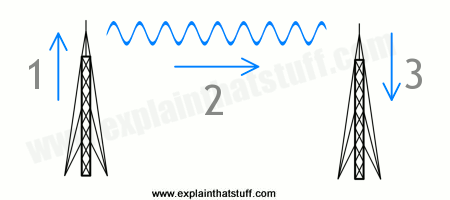Radio Waves
Radio waves are some of the most
interesting electromagnetic waves that are utilized by
people. Radio waves are the main Electromagnetic wave
involving communication. The music from our radios, the
texts we send, the calls we make, and much more are all
the result of radio waves. Humans learned along time ago
how to transfer a signal using these waves and are still
used everyday by most people.
Radio wave frequencies can range
anywhere from 3kHz to 300GHz. This is why radio waves are
so convenient for sending signals. We can fine tune our
frequency to exactly what we want in the large range and
the device receiving the signal can interpret the wave in
many different ways. Radio waves are sent and received by
antennas. The source of a radio wave is called the
transmitter and the receiving end is called the receiver.
So when a radio station plays a song they are the
transmitter and your car would be the receiver. This works
the same way for phones but instead the phone transmits
the signal to a satellite which then increases the
strength of the signal and transmits the signal down to
the receiver of the call.
 |
| http://www.explainthatstuff.com/antennas.html |
So how does all this actually work?
Well a radio can receive a signal in two different ways,
AM(Amplitude Modulation) and FM(Frequency Modulation).
When a radio broadcaster talks through his/her microphone
an electric signal is then produced. This signal is then
transmitted through an antenna to the vicinity around the
station. Now depending on if you set your radio to AM or
FM you will receive a different broadcast.
AM radio relies on a consistent
frequency and a variable amplitude. AM radio usually falls
in a frequency range of 520kHz to 1710kHz. On the radio
the user will set the radio to a desired frequency which
will be dependant on which station they would want to
listen to. The information in the signal is actually
created by the wave changing amplitude. AM radio is
convenient for long ranges and being able to have more
stations within a smaller range of frequencies. The
downsides to AM radio is that it is easier to disrupt the
signal and AM has a very limited audio range which is not
great for music.
FM radio is the opposite of AM radio.
Instead of having a constant frequency FM radio has a
constant amplitude. This means that the information being
sent through the signal is actually dependent on
frequency. When tuning into an FM station you are actually
turning into a steady amplitude. FM radio is great for
music due to having a large audio range but the signal
cannot be sent over a very large range.
